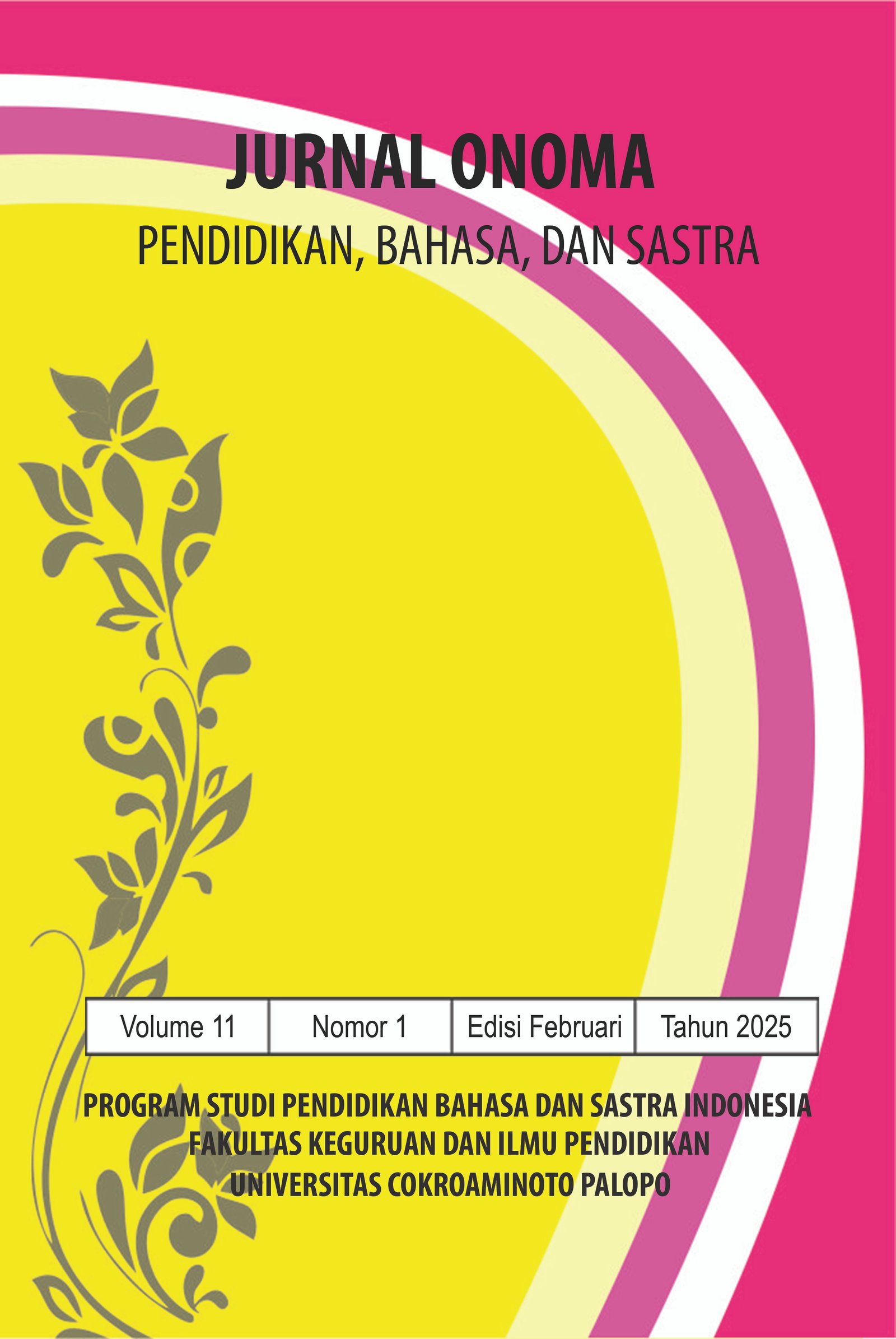Kepercayaan Jawa dalam Bingkai Realisme Magis pada Novel Gong Nyai Gandrung karya Sekar Ayu Asmara
https://doi.org/10.30605/onoma.v11i1.4941
Keywords:
novel, gong nyai gandrung, sekar ayu asmara, realisme magis, wendy b. farisAbstract
Penelitian ini bertujuan mendeskripsikan karakteristik realisme magis dan kepercayaan Jawa dalam novel Gong Nyai Gandrung karya Sekar Ayu Asmara. Beragam ekspresi budaya di Indonesia menyebabkan tumbuhnya kepercayaan magis di masyarakat ditambah adanya ritual dan upacara yang melibatkan unsur magis yang memperkuat keyakinan seseorang. Oleh karena itu, fokus penelitian ini menemukan kepercayaan Jawa yang terbingkai di dalam realisme magis. Pemilihan topik ini diteliti sebab di dalam novel ditemukan karakteristik realisme magis maka dari itu teori yang digunakan adalah Wendy B. Faris. Peneliti menerapkan metode kualitatif sehingga dapat mendeskripsikan dan menginterpretasikan data-data tertulis yang tertuang di dalam sumber data yaitu berupa prosa. Hasil yang diperoleh dalam penelitian ini menunjukkan keberadaan karakteristik realisme magis, yaitu unsur yang tak tereduksi, dunia yang fenomenal, kenyataan yang bercampur magis, keraguan-raguan yang menggangu, dan kekacauan terhadap waktu, ruang, dan identitas. Narasi realisme magis yang terdapat di dalam novel ini mengandung kepercayaan Jawa yang didominasi oleh benda magis, kepercayaan terhadap leluhur, ritual, dan kepercayaan tradisional yang berhubungan dengan upacara pernikahan adat Jawa.
Downloads
References
Andalas, I., Nugroho, B. A., & Mulyani, A. (2018). Realisme Magis Dalam Delirium Mangkuk Nabi Karya Triyanto Triwikromo. Pertemuan Ilmiah Bahasa Dan Sastra Indonesia (PIBSI), 201(2002), 201–212. https://proceeding.unikal.ac.id/index.php/pibsi40/article/view/45
Darma, B. (2019). Pengantar Teori Sastra. Penerbit Buku Kompas.
Emiliyah, N., & Darni. (2021). Kepercayaan Dalam Novel Ringin Garing Karya Tulus Setiyadi Stp. (Kajian Antropologi Sastra). Baradha, 17(1), 385–411.
Farahsati, W., Rachmawati, K., & Susanto, A. (2023). Etnografi Masyarakat Bali Dalam Novel Tarian Bumi Karya Oka Rusmini. Bastra, 8(2), 176–191. https://doi.org/10.26499/jk.v14i2. DOI: https://doi.org/10.29103/jk.v2i2.5467
Faris, W. B. (2004). Ordinary Enchantments Magical Realism and the Remystification of Narrative. Vanderbilt University Press. DOI: https://doi.org/10.2307/j.ctv17vf68f
Karmini, N. (2020). Teori dan Apresiasi Prosa Fiksi (1st ed.). Pustaka Larasan.
Karuniawan, D. Y., & Tjahjono, T. (2023). Mistisisme Dalam Novel Janur Ireng Karya Simpleman (Kajian Mistisisme Jawa Niels Mulder). Bapala, 10(1), 93–103.
Lotong, Y., Nensilianti, & Abidin, A. (2024). Nilai Magis Dalam Novel Sunyaruri Karya Risa Saraswati Teori Realisme Magis. Journal of Applied Linguistics and Literature, 1(2), 189–197. https://doi.org/10.59562/jall.v1i2.1926 DOI: https://doi.org/10.59562/jall.v1i2.1926
Nurgiyantoro, B. (2019). Teori Pengkajian Fiksi. Gadjah Mada University Press.
Sundusiah, S. (2015). Memahami Realisme Magis Danarto Dan Marquez. LINGUA: Journal of Language, Literature and Teaching, 12(1), 123–136. https://doi.org/10.30957/lingua.v12i1.76 DOI: https://doi.org/10.30957/lingua.v12i1.76
Yudono, K. D. A., Sitanggang, G. L., & Widiyanto, N. (2023). Realisme Magis dalam Naskah Drama Kejahatan Membalas Dendam Karya Idrus Tahun 1948. Indonesian Journal of Performing Arts Education, 3(1), 8–14. https://doi.org/10.24821/ijopaed.v3i1.8602 DOI: https://doi.org/10.24821/ijopaed.v3i1.8602
Yulianti, E., Sudewa, I. K., & Nama, I. K. (2018). Kepercayaan Tradisional Masyarakat Jawa dalam Novel Suti Karya Sapardi Djoko Damono: Kajian Sosiologi Sastra. Humanis, 22(3), 579–584. https://doi.org/10.24843/jh.2018.v22.i03.p02 DOI: https://doi.org/10.24843/JH.2018.v22.i03.p02
Downloads
Published
How to Cite
License
In submitting the manuscript to the journal, the authors certify that:
- They are authorized by their co-authors to enter into these arrangements.
- The work described has not been formally published before, except in the form of an abstract or as part of a published lecture, review, thesis, or overlay journal.
- That it is not under consideration for publication elsewhere,
- That its publication has been approved by all the author(s) and by the responsible authorities – tacitly or explicitly – of the institutes where the work has been carried out.
- They secure the right to reproduce any material that has already been published or copyrighted elsewhere.
- They agree to the following license and copyright agreement.
License and Copyright Agreement
Authors who publish with Onoma Journal: Education, Languages??, and Literature agree to the following terms:
- Authors retain copyright and grant the journal right of first publication with the work simultaneously licensed under Creative Commons Attribution License (CC BY 4.0) that allows others to share the work with an acknowledgment of the work's authorship and initial publication in this journal.
- Authors are able to enter into separate, additional contractual arrangements for the non-exclusive distribution of the journal's published version of the work (e.g., post it to an institutional repository or publish it in a book), with an acknowledgment of its initial publication in this journal.
- Authors are permitted and encouraged to post their work online (e.g., in institutional repositories or on their website) prior to and during the submission process, as it can lead to productive exchanges, as well as earlier and greater citation of published work.

















